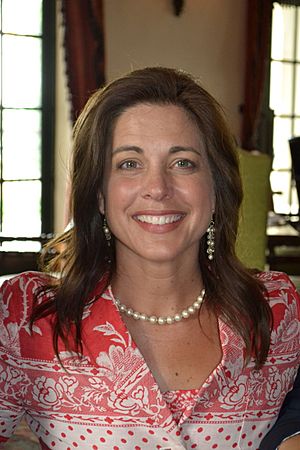Heather Whitestone facts for kids
Quick facts for kids
Heather Whitestone
|
|
|---|---|

Whitestone in 2012
|
|
| Born |
Heather Leigh Whitestone
February 24, 1973 Dothan, Alabama, U.S.
|
| Alma mater | Jacksonville State University |
| Occupation | Motivational speaker and author |
| Known for | First deaf Miss America |
| Title | Miss Alabama 1994 Miss America 1995 |
| Predecessor | Kimberly Clarice Aiken |
| Successor | Shawntel Smith |
| Spouse(s) |
John McCallum
(m. 1996) |
| Children | 4 |
Heather Leigh Whitestone McCallum (born February 24, 1973) is an American speaker and former beauty queen. She made history as the first deaf person to win the Miss America title. Heather lost most of her hearing when she was just 18 months old.
Early Life and Education
Growing Up in Alabama
Heather Whitestone was born in Dothan, Alabama. When she was 18 months old, a serious ear infection caused her to lose most of her hearing. This meant she could not hear sounds very well.
Finding Inspiration in Helen Keller
In fourth grade, Heather learned about Helen Keller. Helen Keller was also deaf and blind, but she achieved amazing things. Helen became a big role model for Heather. Heather wanted to learn and succeed just like Helen.
Catching Up in School
Because of her hearing loss, Heather found it hard to keep up with her classmates. She asked her family to send her to a special school. She went to the Central Institute for the Deaf in St. Louis, Missouri. There, she learned two grade levels each year. After three years, she had caught up with other students. She then returned to Alabama and graduated from public high school with a good grade point average.
Passion for Ballet
When Heather was sixteen, she moved to Birmingham after her parents divorced. She spent a year at the Alabama School of Fine Arts. She graduated from Berry High School in 1991. Heather loved ballet and spent a lot of time practicing. This passion grew even stronger after her hearing loss. Later, she studied at Jacksonville State University.
Becoming Miss America
Starting with Pageants
Heather first joined the Shelby County Junior Miss program. This experience helped her feel more confident. It encouraged her to enter beauty pageants. Her first year in the Miss America system, she won the Miss Jacksonville State University title. After that, she became Miss Alabama.
Winning the Crown
In the finals of the Miss America 1995 pageant, Heather stood next to Miss Virginia. When the first runner-up was announced, Heather could not hear the host, Regis Philbin. However, she could read his lips. She was surprised and looked at the other contestant to make sure she had won. She had! Heather Whitestone became the first deaf Miss America.
Her S.T.A.R.S. Program
As Miss America, Heather traveled the country sharing her S.T.A.R.S. program. S.T.A.R.S. stands for "Success Through Action and Realization of your dreams." This program has five important points:
- Having a positive attitude
- Believing in your dreams
- Being willing to work hard
- Facing challenges
- Building a strong support team
Heather also worked on the President's Committee on Employment of People with Disabilities. She has written four books.
Life After Miss America
Continuing Her Education and Advocacy
After her Miss America win, Heather finished her studies at Jacksonville State University. She continued to raise awareness about issues important to deaf people. She also often speaks about her strong faith. She wrote about her life in her book, Let God Surprise You: Trust God with Your Dreams.
Public Speaking and Family Life
Heather is a motivational speaker. She lives in Georgia with her husband, John McCallum. They met when John worked for Speaker Newt Gingrich in Congress. They have four children: John Jr., James, Wilson, and William.
Cochlear Implant Surgery
In 2002, Heather decided to have a cochlear implant operation. This surgery helped her hear to some extent in her right ear. She had lost hearing in that ear when she was 18 months old. The surgery happened on August 6 in Baltimore. She said her main reason for the surgery was not hearing her son cry for help one time. She has said she does not regret her decision.
Other Roles and Appearances
Heather was appointed to the National Council on Disability by President Bush. She also served on the board of the Helen Keller Foundation for Research and Education. In 2002, she joined the Advisory Council for the National Institutes of Health on Deafness and Other Communication Disorders.
Heather has appeared on TV shows like CNN, ABC's Good Morning America, and The View. She has also been featured in magazines like USA Today and People Magazine. In 2003, she filmed public service announcements for "Dogs for the Deaf." This organization trains hearing dogs to help people.
Heather has also been a spokesperson for the Starkey Hearing Aid Foundation and Cochlear America.
Her Books
Heather Whitestone has written four books:
- Listening with My Heart
- Believing in the Promise
- Let God Surprise You
- Heavenly Crowns
She also led a large public service campaign to help identify early hearing loss. This campaign was created by the Miss America Organization and the Alexander Graham Bell Association for the Deaf.


